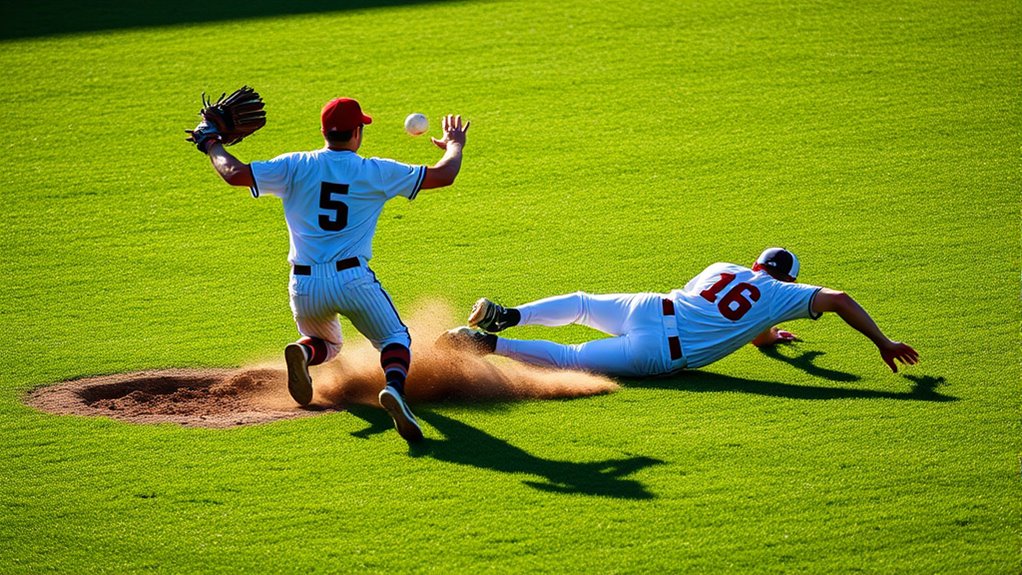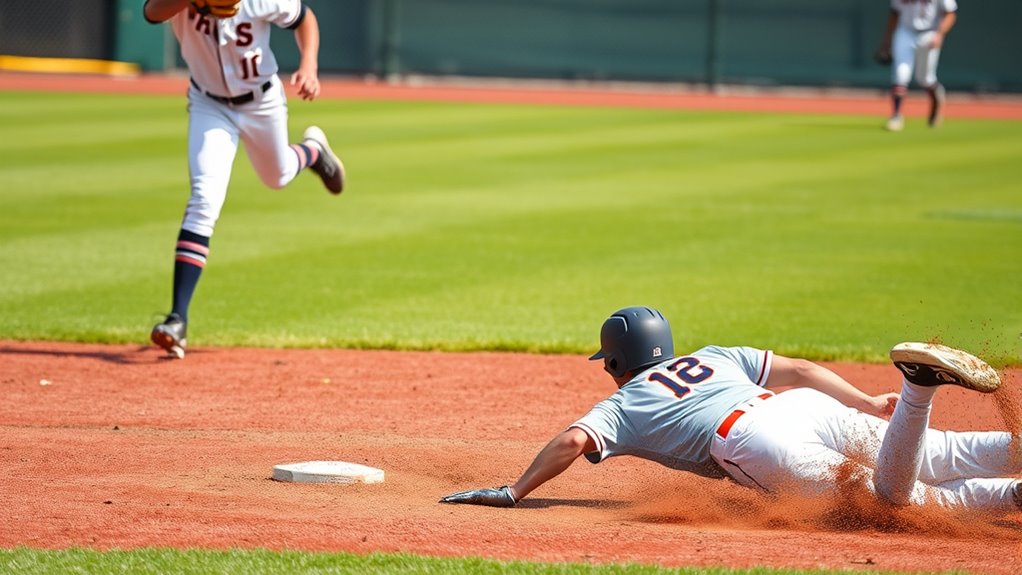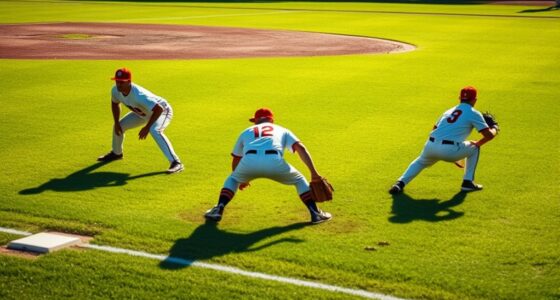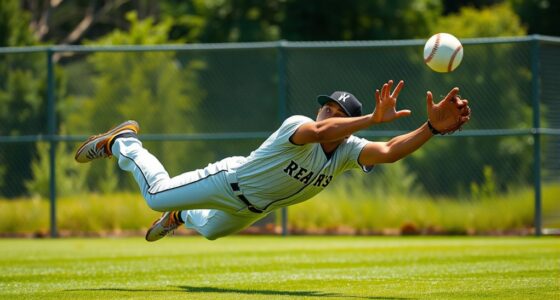To excel in infield dynamics, you need seamless teamwork, quick reactions, and clear communication. Master pivot techniques, stay light on your feet, and transfer the ball swiftly during double plays. Use proper footwork to change direction quickly and improve transfer speed. Incorporating tech-inspired drills can boost your agility. Effective signals and verbal cues help coordinate actions, reducing errors and making highlight-worthy plays. Keep honing these skills, and you’ll reveal the secrets behind exceptional infield defense.
Key Takeaways
- Seamless teamwork and quick reactions are essential for turning double plays effectively.
- Mastering pivot techniques and proper footwork ensures swift ball transfer and positioning.
- Efficient communication, including signals and verbal cues, enhances infield coordination and reduces errors.
- Quick transfer speed and correct footwork minimize delays during double plays.
- Incorporating technology and innovative drills can improve reaction time and overall defensive agility.

Have you ever wondered what makes an infield truly effective? It all comes down to the seamless coordination and quick decision-making that turn routine plays into defensive gems. One of the most essential skills you can develop is mastering pivot techniques. When you’re involved in a double play, your ability to pivot efficiently can make the difference between a smooth, quick out and a costly error. To execute a perfect pivot, you need to stay light on your feet, anticipate the throw, and position yourself correctly. Proper footwork ensures you’re ready to transfer the ball swiftly and accurately. A solid pivot technique allows you to change direction swiftly, helping you get the ball out of your glove and into the baseman’s hand with minimal delay. This speed is indispensable during double plays, where every fraction of a second counts. Arcade Machine technology and design principles can even inspire training tools to improve reaction time and coordination. But even the best pivot techniques won’t matter if communication strategies aren’t in sync. Effective communication on the infield is essential for coordinating plays and avoiding collisions or missed opportunities. You should use clear, concise signals—whether verbal or non-verbal—to alert your teammates about your intentions. For example, calling out “double play” or using specific hand signals can prepare your teammates for the next move. Maintaining eye contact and using body language can also enhance communication, especially in high-pressure situations. When everyone’s on the same page, your team can react more instinctively, which speeds up the entire process. Good communication also involves listening—pay attention to your teammates’ cues and be ready to adjust your position or move quickly if the play demands it.
Frequently Asked Questions
How Do Infielders Communicate During Complex Double Plays?
During complex double plays, you rely on clear communication with your teammates. Use verbal cues to quickly alert others about your intentions, like calling for the ball or indicating your position. Hand signals also play a key role, especially when noise levels are high or quick reactions are needed. Combining verbal cues with hand signals guarantees everyone stays synchronized, helping you execute double plays efficiently and prevent errors on the field.
What Are Common Mistakes to Avoid During a Double Play?
When executing a double play, you should avoid common mistakes like poor footwork, which hampers your double play fundamentals, and sluggish infielder agility, leading to missed opportunities. Make sure to communicate clearly with teammates and anticipate the ball’s movement. Stay low and quick on your feet, and practice your timing to guarantee smooth, efficient double plays. Avoid rushing or hesitating, which can cause errors and give the offense an advantage.
How Does Infield Positioning Change Against Different Batters?
Positioning pivots perfectly to play against batting tendencies, you should vary your stance and shift strategically. When facing power hitters, tighten your toes and tighten your stance for quick reactions, while against speedy bunters, shift slightly towards the ball’s likely direction. Defensive shifts dynamically dictate your placement, helping you anticipate and adapt, so you’re always prepared to pounce on the play. Proper positioning pays off with fewer errors and more outs.
What Drills Improve Quickness for Turning Double Plays?
To improve your quickness for turning double plays, focus on agility drills that enhance your foot speed and reaction time. Practice quick glove exchanges and footwork patterns, such as ladder drills or cone drills, to develop better agility. Incorporate reaction time exercises like rapid tosses or partner drills that require you to respond swiftly. Consistently training these areas will help you execute double plays more efficiently and with greater confidence.
How Do Weather Conditions Affect Infield Defensive Strategies?
Did you know that infielders’ reaction times slow down by up to 20% in extreme weather? Weather conditions considerably impact your defensive strategies; for example, field surface becomes slick or uneven, and temperature effects can make the ball bounce unpredictably. You need to adjust your positioning and footing accordingly, especially during rain or extreme heat, to maintain peak agility and guarantee successful plays.
Conclusion
Mastering infield dynamics turns routine plays into defensive gems. Imagine you’re in a tight game, and you quickly turn a double play, preventing the opposing team from scoring. Like a skilled shortstop, your quick reflexes and teamwork can change the game’s outcome. Focus on positioning, communication, and timing. When you master these, you’ll become the player everyone relies on in clutch moments, making those game-changing plays that leave fans and coaches in awe.









